|
| |
| |
Hello!
Dear Friend,
It’s hard to believe, but this month marks one year of sheltering-in-place and other COVID-related restrictions in the Bay Area. We know it’s been a challenging year for all, and we hope that you and your families are continuing to stay healthy.
Mt. Tam and the surrounding public lands have certainly been a bright spot for all of us during the last year. It's where we’ve gathered for socially distanced walks and bike rides with family and friends and where we’ve gone when we needed a quiet moment in nature. Thank you to our One Tam members who have supported us during this time. If you’re not yet a member, please consider joining us today.
Looking ahead, we’ve got a great event coming up this Friday with naturalist Christian Schwarz. Applications for our popular summer youth program, LINC, are now live. And we’re looking for volunteers to help us protect sensitive foothill yellow-legged frog habitat this spring! Read on for more stories from the field.
And finally, thanks to those of you who joined our Birds & Bees on Mt. Tam Member Webinar in February with speakers Renee Cormier from Point Blue Conservation Science, and Gretchen LeBuhn from San Francisco State University. in February. We had over 60 participants and some great questions. If you missed it, you can view the presentation here.
Cailey Gibson
Associate Director, Individual Giving, One Tam
|
| |
|
| |
Check out these upcoming virtual events!
- March 5, 7:00-8:30 pm: “Data Is Not the Destination” talk and conversation with Christian Schwarz. Discover the meaning and possibility of community science through the world of mushrooms and their enthusiasts. Christian Schwarz is a naturalist based in Santa Cruz who photographs, teaches about, collects, and researches macrofungi. He is coauthor of Mushrooms of the Redwood Coast. Register here >>
- March 18, 4:00-5:00 pm: Bay Nature Talks: People, Science, and Nature at One Tam. Join Dr. Lisette Arellano, Community Science Program Manager at One Tam, in conversation with author Mary Ellen Hannibal, science journalist and author of Citizen Science: Searching for Heroes and Hope in the Age of Extinction.
- City Nature Challenge 2021, April 30-May 3. Mark your calendars now! We're excited to connect the One Tam community with City Nature Challenge virtually again this year - an international celebration of biodiversity and nature where you are! See the most common local species observed last year here. What will you find in 2021? Please stay tuned for details on our calendar and this e-news.
|
LINC INTERNSHIP APPLICATIONS DUE MARCH 15!
|
|
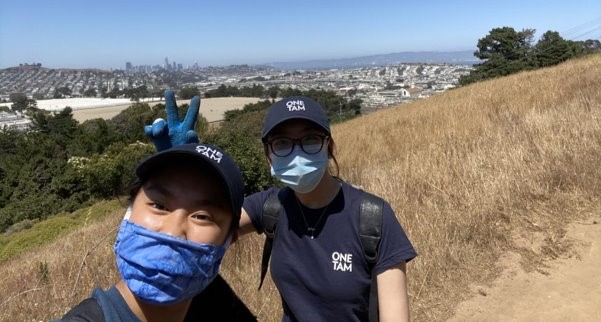
|
|
LINC 2020 students participate in a park cleanup, following local health department guidelines. Photo: Grecia Solis Pacheco / One Tam
|
|
We are now accepting LINC 2021 Applications! This popular five-week program (Linking Individuals to their Natural Communities) brings together youth from across the Bay Area for a variety of local service projects while deepening their understanding of ecology and climate change and providing workshops to gain career and leadership skills.
Projects and activities will vary by week and may include plant identification and habitat restoration. At the conclusion of the program, all participants receive a $500 cash award.
Please see the application for details on this year’s program format. Pending COVID-19 safety restrictions, we may celebrate with an overnight camping or backpacking trip.
Applications are due March 15. Please share with young people in your life who might be interested!
|
| |
One Tam Conservation Management Team Supports CA State Parks with Native Plantings
|
|
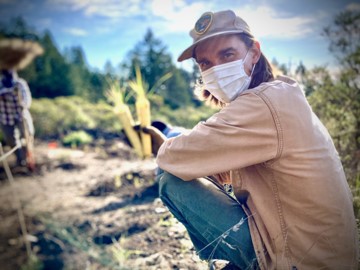
|
|
Michael Sturtevant prepares to plant native grasses along Deer Park Fire Road following road rehabilitation. Photo: Monica Stafford / One Tam
|
|
This winter, One Tam’s Conservation Management team supported Mount Tamalpais State Park by planting roughly 500 plants along the Deer Park Fire Road above Muir Woods.
The team conducted two rounds of planting, focusing on herbaceous plants and grasses to support the enhancement of native grasslands while also controlling erosion along the road. The plants were grown at the Golden Gate National Parks Conservancy’s Marin Headlands plant nursery and included California blackberry, pearly everlasting, yarrow, and gray rush alongside grasses like purple needlegrass, blue wild rye and red fescue.
By planting these native species, State Parks aims to help prevent erosion and facilitate the natural recruitment of plants from the surrounding habitat. In turn, the team hopes to reduce opportunities for invasive plants in this pocket of grasslands.
This surveying and planting work played to the Conservation Management team’s strengths. As David Greenberger, Assistant Conservation Management Specialist, put it, “we know the land out there really well, including the threats in terms of weeds. Luckily, we have the protocols to deal with those while helping support native grasslands.” He also noted that the grasslands in the area support a rich diversity of species in addition to those planted in construction areas.
The team will be back out in the area this spring and summer to continue their monitoring work.
|
| |
Do Your Part to Protect Yellow-Legged Frogs This Season!
|
|
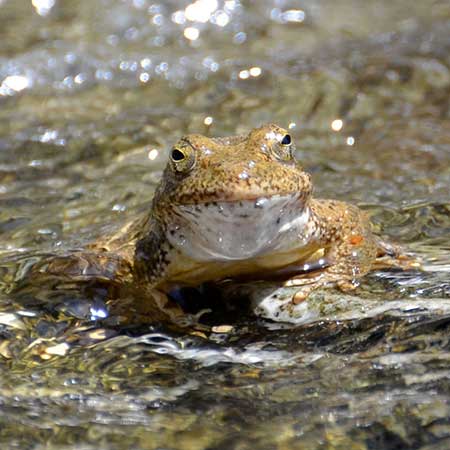
|
|
Foothill yellow-legged frog. Photo: Ian Austin
|
|
Did you know that Mt. Tam is home to the sensitive foothill yellow-legged frog? Foothill yellow-legged frog range and numbers have declined dramatically in Marin County and in the One Tam region over the last 75 years. They are now only found in Big and Little Carson Creeks on the Mt. Tamalpais Watershed, and in San Anselmo Creek in Cascade Canyon Open Space Preserve. These popular Marin hiking destinations are also important breeding habitat for the foothill yellow-legged frog, a federal and state species of special concern.
The frog populations are threatened and are easily damaged if park visitors or their dogs go into the waters around the falls. Please limit disturbance of the frogs, the eggs, and the tadpoles by staying out of the water and do your part for conservation!
Want to do more? Please join One Tam partner Marin Water for a two-part virtual Frog Docent training on Saturdays, March 13 and March 20 from 9-10:30 am. Learn about this threatened species and what you can do to protect its breeding habitat. Get outside and become a community scientist by educating visitors about this incredible species and the freshwater habitat crucial to its survival. To register, email volunteerprogram@marinwater.org or call 415-945-1128.
|
| |
More Support for Monarchs
|
|

|
|
Monarch butterfly. Photo: Morgan Stickrod via iNaturalist
|
|
This week, the Xerces Society released the data from the fifth annual Western Monarch New Year's Count, which includes data from the local community science effort to count migratory monarchs at overwintering sites, coordinated by NPS Ranger and Marin Community Liaison Mia Monroe and supported by One Tam. She shared that while overall both the Thanksgiving and New Years’ Counts were alarmingly low, monarchs did remain at several Marin sites between the two counts. They will hopefully become the first breeding generation of the year.
What happens now? There's more to observe and help document: the second annual Western Monarch Mystery Count is a community science effort where everyone can help document monarchs moving east, into inland Marin communities. You might see them finding nectar in your garden or undertaking spring re-migration/dispersal when out on a sunny day hike. Documentation of presence and behavior early in the season through this iNaturalist-based effort adds invaluable information to a gap in our knowledge! Check out more ways you can help here.
We are also excited to announce that the Parks Conservancy was recently awarded a grant from the California Wildlife Conservation Board’s Monarch Butterfly and Pollinator Program. This will support monarch overwintering site assessments and enhancements on both National Park Service and Marin County Parks lands. Stay tuned to future e-newsletters for updates and connections to this work.
|
| |
Help Us Learn More about Coyotes in Marin
|
|

|
|
Photo: Kirke Wrench
|
|
The howl of coyotes at night is a peak sensation we experience in Marin’s landscapes, and there’s a new way that you can help protect them. You can contribute to the National Park Service’s Marin Coyote Study by providing location information if you encounter a coyote carcass (including roadkill). Part of this research involves collecting small samples for DNA analysis to gain information about population, diet, and genetics. Please contact Katie Smith (katie_smith@partner.nps.gov) with information and location details.
And please upload your coyote observations with photos to our Tracking Coyotes in Marin iNaturalist project! Learn what NPS is looking for and please remember to maintain a generous distance at all times to help keep coyotes safe!
|
| |
| |
iNaturalist Observation of the Month
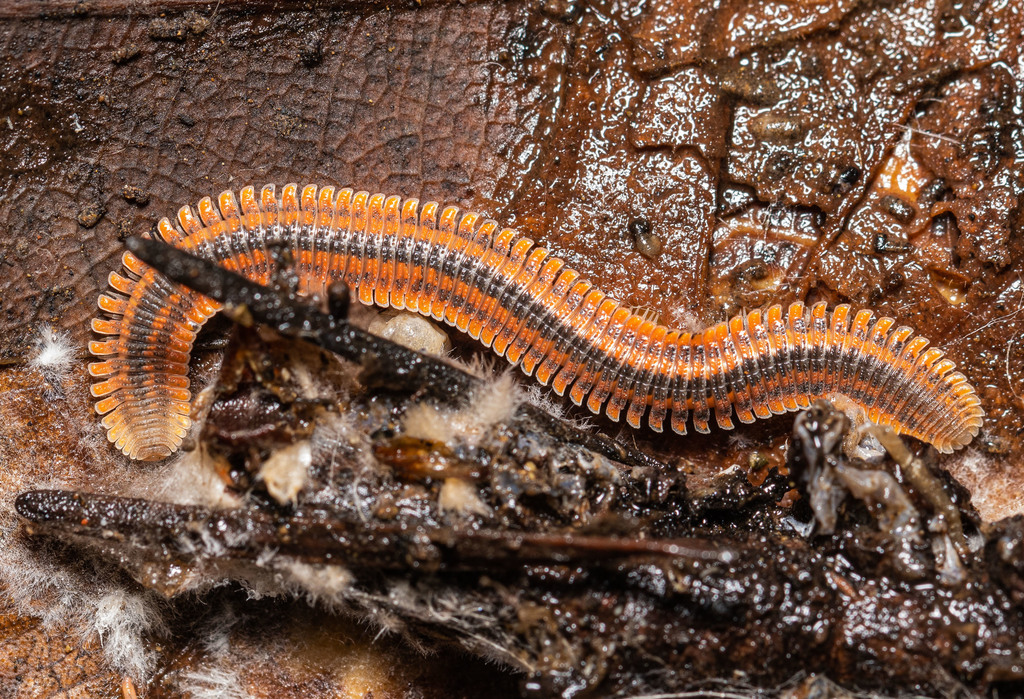 |
|
Millipede (Brachycybe producta). Photo: Jeremiah Degenhardt via iNaturalist
|
| |
Millipedes find refuge under logs and pieces of bark along with other insects, snails, slugs, and salamanders. This millipede is in the genus Brachycybe, a group that mostly eats fungi (photo), lives in multigenerational groups, and is a rare example of paternal care in arthropods. Brachycybe fathers guard their eggs until they hatch and are known to clean eggs to keep fungal infections away. Biologist and iNaturalist member Jeremiah Degenhardt kindly shared his photos, expertise about millipedes, and an excellent reminder about caring for our forest neighbors: “This particular individual was found under a small piece of bark, wrapped around the eggs. I took care to replace the bark after taking this photo so as to not disturb the individual too much.”
|
|
| |
About Us
|
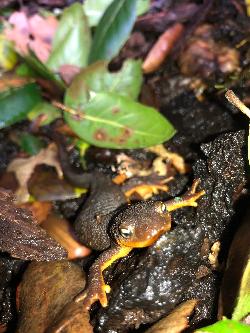 |
|
A California newt at Lake Lagunitas on Mt. Tam
|
|
One Tam works to ensure a healthy, vibrant and diverse landscape for our beloved and iconic Mt. Tam. We are the community-supported partnership of Mt. Tam’s land agencies and managers.
One Team leads programs that care for our mountain, inspire our next generation of land stewards and strengthen our local community. We invite you to join us.
|
|
| |
|

Going Further, Together
|
|
One Tam brings together inspired community members with its five partners to support the long-term stewardship of Mt. Tam.
|
| |

|
| |
|